Matomo is a flexible open-source analytics platform recognized for its extensive functionalities and adaptability. It empowers organizations to monitor and analyze website traffic, user interactions, and marketing campaign effectiveness. With various plugins and customizable features, it facilitates personalized analytics solutions without requiring advanced technical knowledge. When it comes to hosting Matomo, Hetzner is preferred due to its scalable infrastructure and seamless deployment options. ServerAvatar makes the deployment of the Matomo application on the Hetzner platform an easy step-by-step process.
Create a Server in Hetzner
Getting Started with Hetzner:
Hetzner provides a range of services like dedicated hosting, virtual private servers, colocation services, and domain registration. Hetzner is known for having reliable systems and competitive prices in web hosting. Its services work well for both individual users and businesses that need strong hosting options.
Step 1: Login to Hetzner Cloud Console
- Go to the Hetzner Cloud website and sign in using your credentials.
Step 2: Create a New Project (Optional)
- If you don't have an existing project, create a new one by clicking on the New Project button.
![]()
- Enter a name for your project and click Add Project.
![]()
Step 3: Select a Project
- Select the project in which you wish to create your server.
![]()
Step 4: Create a New Hetzner Cloud Server
- Navigate to the Servers sub-menu and click on Add Server to begin creating your server.
![]()
Step 5: Configure your server
-
Select a Location: Select the data center location where you want to deploy your server. Choose the region that is closest to your target audience for better performance.
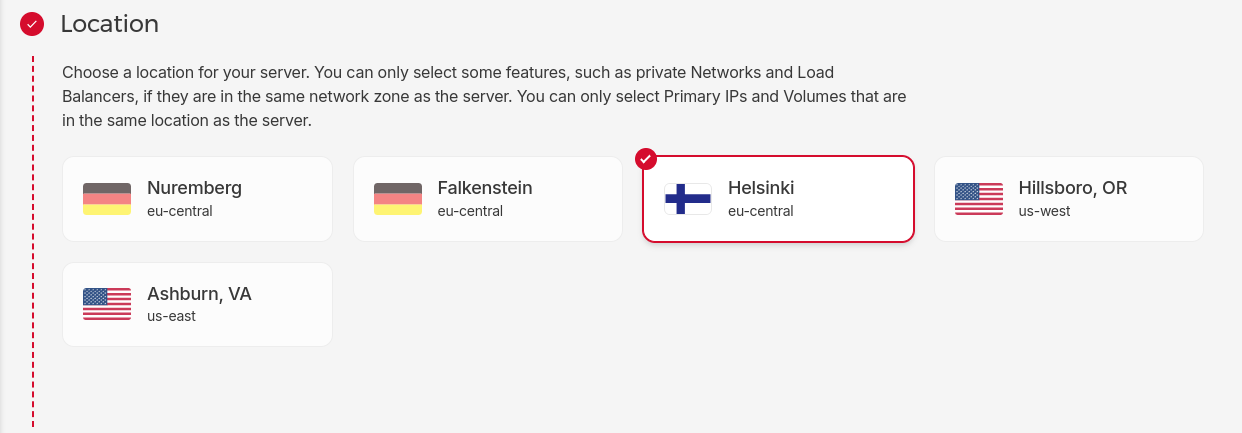
-
Select an Image: ServerAvatar supports both Ubuntu 20.04 and Ubuntu 22.04. Therefore, choose one of these supported operating systems.
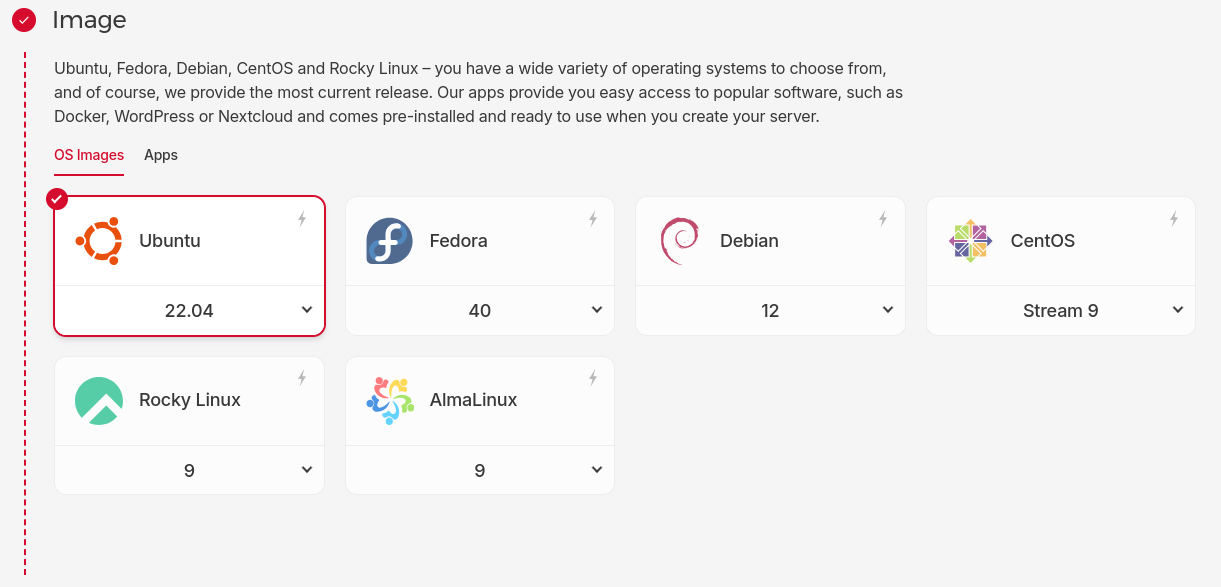
-
Select a Server Type: Hetzner provides various plans with different configurations of CPU, RAM, and storage. Select the server type based on your requirements. Generally, the Matomo application required 1GB or more of RAM for better performance and 1GB or more of disk space required for additional space based on data volume and log retention. You can select another plan of higher configuration as per your requirements and usage.
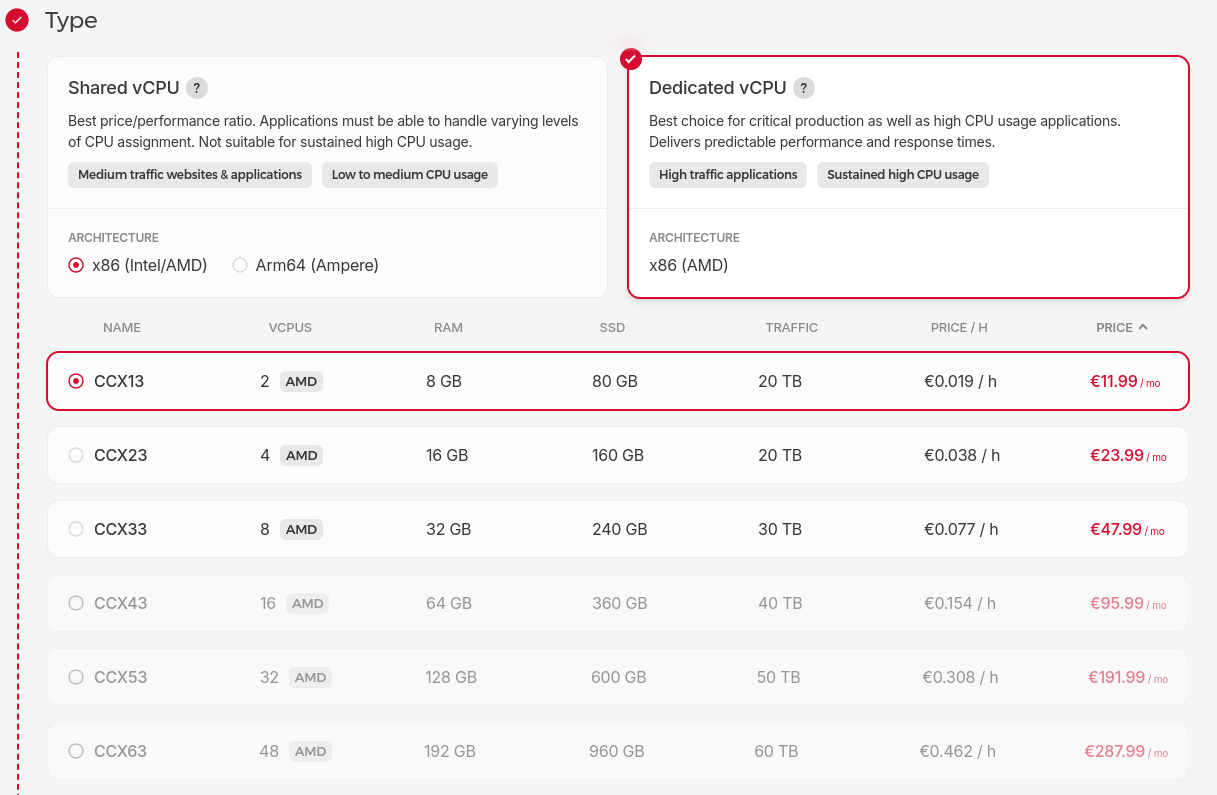
-
Select Networking: Select from three networking options for your server. Private networks allow you to securely connect servers within the same data center without going over the public internet.
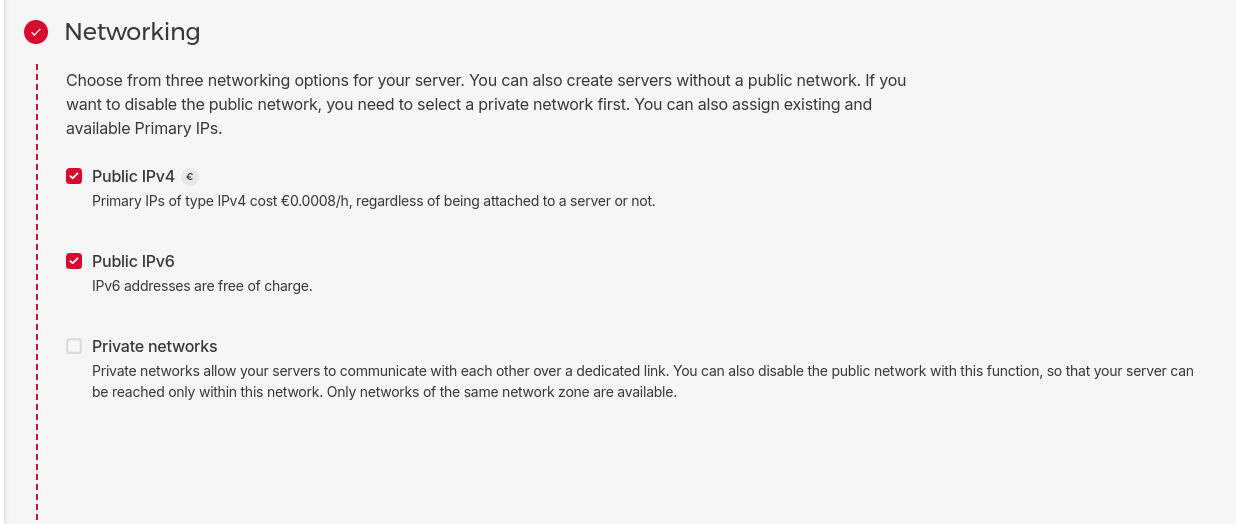
-
SSH Key or Root Password: Select an SSH Key if you want to authenticate with an SSH key. This method is recommended over using a root password for enhanced security. If you choose SSH key authentication, Hetzner will disable password-based authentication by default. Otherwise, you will receive the root password via email.
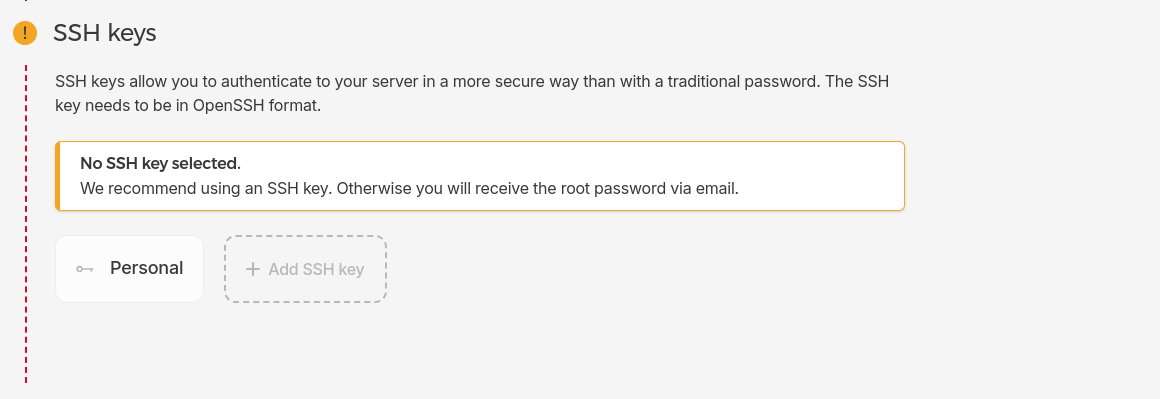
-
Add a Firewall Rule: Configure firewall rules to control incoming and outgoing traffic based on IP addresses, ports, and protocols for improved security.

- Additional Options (Optional): Configure additional options such as Backups, Placement Groups, Volumes, Labels, and Cloud Config as per your Requirements.
-
Give a Server Name: Enter a server name for easy identification.

-
Finalize and Create: Review your configuration settings to ensure that everything is configured correctly. Click on the Create & Buy Now button.9. Finalize and Create: Review your configuration settings to ensure that everything is configured correctly. Click on the Create & Buy Now button.
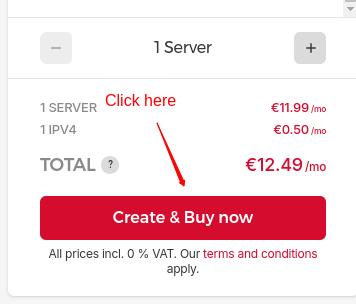
Step 6: Access Your Server
- Once the server is deployed, it will appear on your Hetzner Cloud dashboard. Use the provided IP address and SSH key (if configured) to access your server via SSH. Now, You can connect your Server with ServerAvatar for Server management.
![]()
Initial Server Configuration
The Initial server configuration includes the installation and configuration of various packages required to host your website. Usually, You have to write commands and modify configuration files. Luckily, With ServerAvatar, Your full server configuration and optimization can be automated.
Here are the three ways to automatically configure your server with ServerAvatar.
Connect a server using a direct method
- Login/Register to ServerAvatar account, click the Create button from the right side of the screen, and select Server from the dropdown.
- Select Direct Method in the serve connecting method section.
- Type the Server Name as per your choice.
- Select a Tech Stack as per your need. You can either select Apache, Nginx, OpenLiteSpeed or Node Stack.
- Select a Database: MySQL, MariaDB or MongoDB.
- Enable the toggle if you want to install the latest LTS version of node.js on your server.
- Select a Management plan and click the Connect Now button.
- You’ll see the command on your screen. Login to your server using an ssh connection and execute that command as a root user.
- The server connection process will be started on your ServerAvatar account after executing the command.
Connect a server using integration
- Login/Register to your ServerAvatar account, navigate to the Integration tab from the sidebar of the panel, and access Cloud Platform from the dropdown.
- Now Select a cloud platform you want to link with ServerAvatar.
- The popup form will appear on your screen. Enter details to link your cloud provider account. The integration method is different based on the cloud provider you select.
- You can integrate five different cloud provider platforms with ServerAvatar, which is-
Check the above link of cloud platforms to know more about integrating cloud platforms with ServeAvatar.
Connect a server using commands
Step 1. Login to your server using root user
Once you create a server as per your requirements, connect to your server using an ssh connection and execute the below three commands as a root user in your server console area.
wget https://srvr.so/install
chmod +x install
./install
Step 2. Select a web server
It will ask you which web server you would like to install on your server: Apache, Nginx, OpenLiteSpeed or Node Stack. Type anyone that you would like to install on your server and hit the enter button.
Step 3. Claim your server
Completing the process will give you a link to claim your server.
Open the link on your browser to access the ServerAvatar server panel.
Install and Setup Matomo on Cloud using ServerAvatar
Step1: Create Matomo Database
The Matomo installation process requires database Credentials. So, to create a MySQL database for Matomo, Access the Database tab on the ServerAvatar server panel to create a Database.
![]()
To create a Database, Enter the details, such as the Database Name, in the database creation form like the image below.
![]()
Database successfully created.
Steps 2: Create a PHP Application
Access the Applications tab from the server panel to create a new PHP application for Matomo.
![]()
Now fill up the required details in the application form, as seen in the image below.
![]()
Note that:
If you want to host Matomo on your domain, then make sure to point your domain to the current IP address of your server, and for that:
- Log in to your domain provider site, where you buy your domain. Click here for more info about your domain name.
- Access DNS Manager to edit your DNS records (contact the support team if you don’t find them)
- Change the IP address of A Record of your website to the > current server’s IP address.
To host Matomo on your subdomain, for example, matomo.yourdomain.com, create a new application with the subdomain as your primary domain and follow the same procedure. For accessing Matomo on the subdomain, you need to add your subdomain on A Record that points to the current IP address of your server. To point to an IPV6 address, you would need to use an AAAA record.
Click on Next Step.
Now, choose the method and service provider: Git and GitHub (follow as per the snapshot).
![]()
Continue the process by entering the necessary information as provided below:
Repository Type: Public
Clone HTTPS URL: https://github.com/matomo-org/matomo.git
Branch: 5.x-dev
Deployment script:
composer install;
![]()
Proceed by clicking the "Next Step".
You can either create a new System User or select an existing one.
![]()
Next, choose PHP version 7.2 or above. For the custom Webroot, keep the field empty, as shown in the provided snapshot, as we're specifically seeking "index.php" or "index.html" within the custom setup.
Custom Webroot: (keep this field empty)
![]()
Proceed to the next steps and ensure your details and requirements are accurately entered.
After confirming, click on Create Application to initiate the application creation process.
STEP 3: Install and Setup Matomo
Now access the site URL from the Application panel to install and set up Matomo.
MATOMO INSTALLER
The welcome message screen is displayed upon accessing the URL, as depicted in the snapshot.
![]()
Click next to process further with the system check tab, which will open where you have two options: copy the system check or download the system check. According to your convenience, save or save system check. It is essential to keep it with you in case the Matomo support team asks you for this information.
![]()
DATABASE SETUP
We have already created a database for Matomo in step 1. To establish a connection between the database and the application, enter the database credential we have already made. You can access all your database credentials, like database name, username, and password, by accessing the database tab from the server panel.
Enter the following database credential we have already created in ServerAvatar:
Login: Username of database
Password: Database password
Database Name: Database name
![]()
Process further by clicking on Next.
CREATE SUPERUSER
We have successfully configured the database with Matomo. Now, we create a superuser to log into Matomo after successfully installing and setting up Matomo.
To create a superuser, enter the following details:
Superuser login: dharmilshiroya
Password: your password
Password (Repeat): your password
Email: dharmilshiroya2456@gmail.com
Please remember the credentials you entered above for logging into MATOMO.
![]()
SET UP THE WEBSITE THAT YOU WOULD LIKE TO ANALYZE
Now, Enter the details of the websites you would like to track or analyze with Matomo. For example, I have tried to track and analyze the website URL on which we deploy the Matomo. Please enter your website URL and the name you want to analyze. Here, Matomo provides the advanced option for you who want to use it to analyze e-commerce websites (E-commerce enabled) or Others. If your website is on E-commerce, select E-commerce enable in the E-commerce menu, as seen in the snapshot.
![]()
We had set up a website that you like to track and analyze. We have almost completed the setup process.
The next step is JavaScript tracking code. Do not change anything in the code. Just click on next.
We have successfully installed and set up Matomo on the Server through ServerAvatar. You can see a congratulatory message on your screen.
![]()
Now, log in to Matomo using the superuser credentials we created for the superuser. Please enter the credentials that you provided.
![]()
We have successfully deployed Matomo on Server on ServerAvatar.
Tip:- It will run on HTTP, but to run it on HTTPs ServerAvatar provides a one-click solution to switch to HTTPs for that, go to the SSL Certificate in the application panel and click on force HTTP to HTTPs.